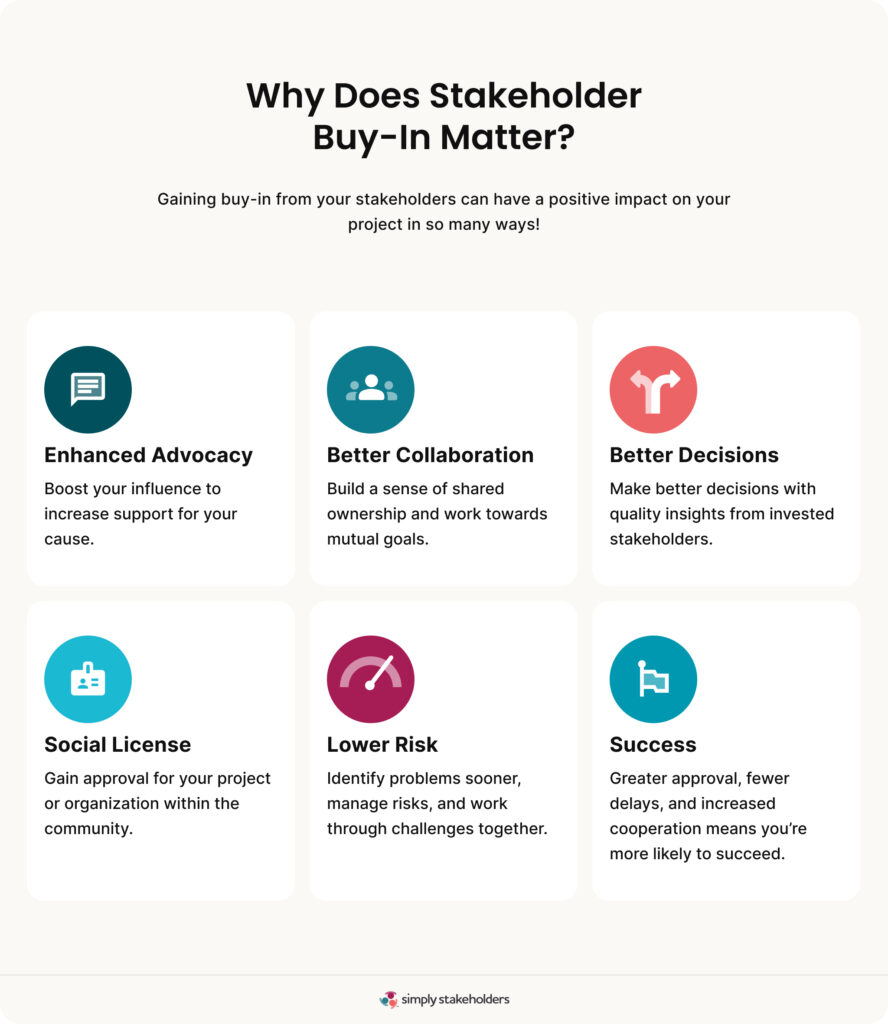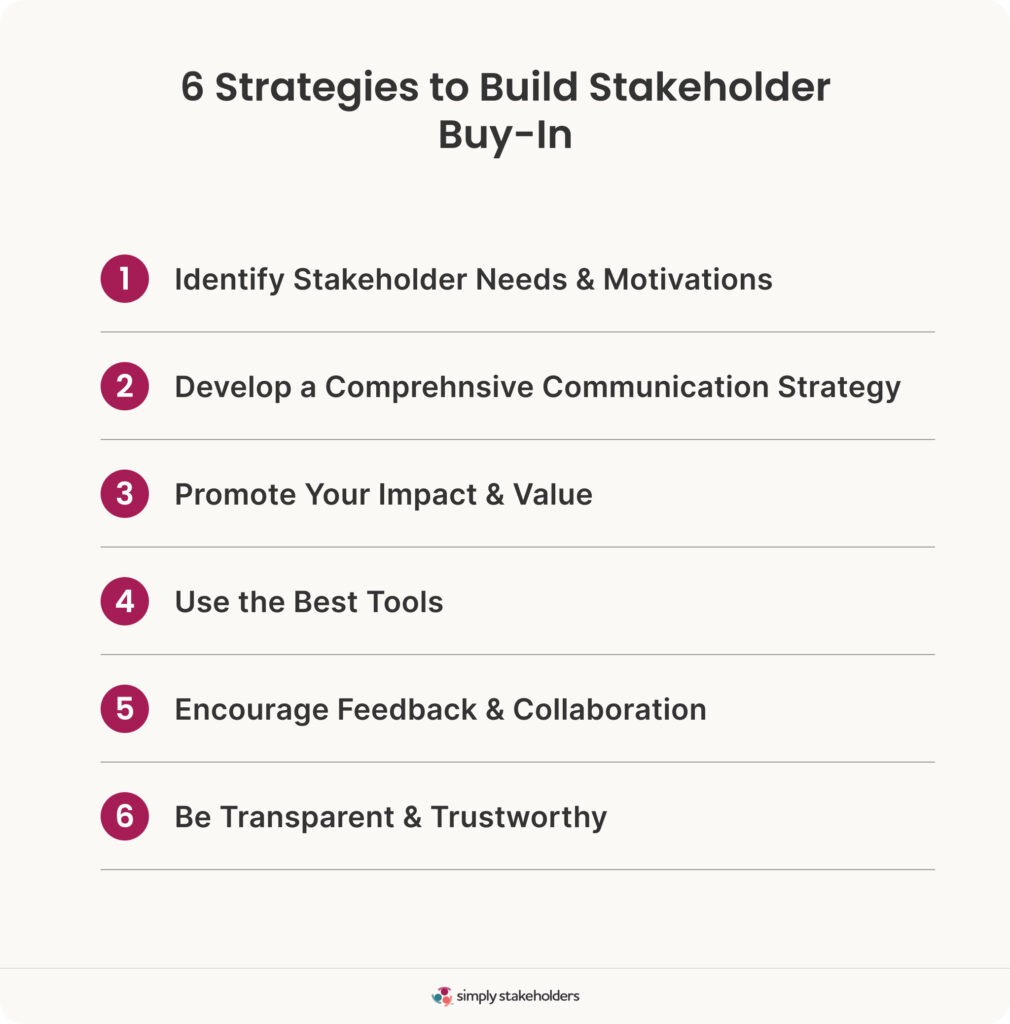Securing Buy-In from Stakeholders: An Overview

Need to secure buy-in from your stakeholders but don’t know where to start? Or looking for a more effective or strategic approach to building stakeholder support?
Buy-in from stakeholders is nearly always a goal in engagement. After all, some degree of stakeholder support is often essential to getting your ideas implemented, working with others, and successfully carrying out your project. But it’s not always an easy goal to achieve.
In this guide, we’ll explore what stakeholder buy-in is, why it’s so important, some challenges to be aware of, and exactly how to get buy-in from stakeholders when it matters most.
What Is Stakeholder Buy-In?
To define stakeholder buy-in, it might be helpful to define each of these terms separately.
- Buy-in refers to the act of committing to an idea, accepting a plan, being willing to participate, or actively supporting an action.
- Stakeholders include the people, groups, and organizations that may be impacted by, have an influence on, or an interest in your project or work.
Bringing both terms together, stakeholder buy-in refers to impacted/interested/influential people and groups supporting, participating in or accepting your project or work.
3 Types of Stakeholder Buy-In
It’s worth considering the different types of buy-in you’ll likely come across when engaging with stakeholders:
- Emotional buy-in – Stakeholders support the project because they feel comfortable, they trust and respect those involved, and they feel connected to the work through their participation or relationships.
- Intellectual buy-in – Stakeholders are aware of and understand the project, and are convinced that it has merit based on a logical consideration of the facts.
- Equity buy-in – This involves financially investing in a company and quite literally buying a ‘stake’.
Keep these types in mind, as different stakeholders may require specific strategies, engagement tactics, and messages in order to encourage them to buy into your project in a way that’s relevant to their goals.
Become a Subscriber Don’t miss out on more insights like this! Subscribe to get our regular updates.
Why Is Stakeholder Buy-In Crucial?

Usually, if stakeholders are important to your project or organization, their buy-in is critical to your success. On the flipside, if you don’t get buy-in from stakeholders (especially your key stakeholders), it could have major consequences for your team, your timelines, and your end result.
Let’s get more specific. Here are six ways stakeholder buy-in can directly impact your project outcomes:
Enhanced Advocacy
Buy-in can be an important component if you’re running a grassroots advocacy campaign and need to bring people together to encourage political change or to influence support for or against a political candidate. If you can get stronger buy-in from more stakeholders you’ll be able to:
- Increase your reach and influence
- Mobilize more resources and funding
- Get more public support for your cause
- Increase your perceived legitimacy
- Overcome opposition
And all of these benefits can help you further build momentum and increase your chances of achieving the desired outcomes for your cause.
Improved Collaboration and Teamwork
The process of getting buy-in often goes hand in hand with improving stakeholder collaboration and your ability to work as a team.
If stakeholders are onboard with your goals and objectives, you’ll avoid a lot of potential misunderstanding and conflicts. And if they feel a sense of shared ownership over the project outcomes or process, stakeholders are more likely to feel accountable, motivated, and committed to the work or organization. This will help to support better communication and transparency between stakeholders, which will facilitate teamwork.
Better Decision Making
The more information you have, the better your decisions can be. When you can achieve buy-in from more stakeholders (especially across a variety of perspectives and backgrounds), you can tap into more information and viewpoints you may not have considered. And stakeholders who have “bought into” your project are more likely to surrender a greater quality and quantity of information that may be helpful, compared to those who are less invested in or supportive of your project.
Long-Term Social License
A social license to operate means gaining the approval or acceptance of relevant stakeholders or community members to carry out your project or work. It means your operations or practices are seen as legitimate and have the unofficial tick of approval to go ahead or continue.
The ideas behind a social license have a lot in common with stakeholder buy-in — both can come from taking a collaborative approach or partnering with key stakeholders. And ensuring stakeholders buy into your organization or project from the start can help you keep stakeholders happy, ensure their acceptance, and build a long-term social license that lasts the duration of your project (and beyond!).
Risk Management and Mitigation
Every project comes with risks — but many of these can be identified ahead of time and managed by working closely with stakeholders and gaining their support. Plus, if you have good relationships with your stakeholders, this will help to carry you through if/when challenges arise or there are problems with the project.
Increased Success
Finally, sufficient stakeholder buy-in from the right stakeholders (and as many stakeholders as possible) can increase the likelihood of a successful project. It can mean fewer delays, greater overall approval, increased cooperation, and other benefits that contribute to your success.
The Challenges in Securing Stakeholder Buy-In
Of course, gaining stakeholder buy-in is easier said than done. It’s a good idea to be aware of the challenges that may come up along the way and how to overcome them, such as:
- Resistance to change – Some stakeholders may resist buy-in because they’re resistant to the change you’re trying to bring about. Try to emphasize the benefits of your project or change, and focus on what aspects of the change they can influence.
- Poor communication – Difficulties in communicating with stakeholders can make it difficult to encourage buy-in. Prioritize communication from the start, and use a variety of approaches and platforms to increase the likelihood of reaching every stakeholder.
- Conflicts – Some stakeholders may hold conflicting views or agendas that go against your work. Securing buy-in from these stakeholders may be challenging, but it’s still worth trying to find a common interest and opportunities to compromise.
- Risk aversion – Some stakeholders may not buy into your project right away because they see it as too risky. For these stakeholders, it’s worth focusing your message on any ways you’re actively managing and reducing risk — and encouraging them to discuss their concerns with you.
- Mistrust – If stakeholders don’t trust your organization, leadership, or the people involved in the project, it can be tricky to get their approval. Try to build credibility and trust by demonstrating your previous successes, your clear plans and processes, and how you’ll follow through on your commitments.
Aside from the above tips, we’ve also got some strategies that will help increase the likelihood of buy-in from stakeholders.
How To Get Buy-In From Stakeholders: 6 Strategies for Success

Curious about exactly how to get buy-in from stakeholders? These 6 strategies will help set up your organization and engagement for greater buy-in from a broader range of stakeholders.
1. Identify Stakeholder Needs and Motivations Early
Stakeholder buy-in comes (at least, in part) from knowing your stakeholders so you can better connect with them. Early on in the project, it’s a good idea to conduct stakeholder analysis to help identify your stakeholder needs and what might be motivating their actions. Then run stakeholder mapping to understand stakeholder impact, interest, influence, relationships, and other important characteristics to help with planning your approach and prioritizing stakeholders.
2. Develop a Comprehensive Communication Strategy
Good communication is a key aspect of how to get buy-in from stakeholders, so make sure you get your stakeholder communication right, from planning and strategizing, to tailoring your key messages and platforms. Ideally, you’ll build out a detailed communication strategy based on your initial stakeholder analysis that outlines what messages you’ll share, when and where you’ll share them, and which stakeholder groups you’ll target.
3. Clarify the Impact and Value
In order for them to get onboard with your project and goals, stakeholders must understand how much potential value your work will bring to their community — or even to them, personally. But you can also go one step further than this and show stakeholders how they themselves can have an impact on both the project and the community by getting involved. For instance, you could outline which aspects of the project are open for consultation and how their feedback, knowledge, and hands-on participation could make a real difference.
4. Use Effective Tools and Technology
There’s a lot of work involved in engaging with stakeholders and managing your relationships. Fortunately, the right tools and technology can help you streamline this work and do a better job of your engagement (which will help to increase buy-in). Rather than recording all your stakeholder information in a spreadsheet, consider using stakeholder software like Simply Stakeholders. With built-in stakeholder analysis, mapping, reporting, and much more, you’ll be able to understand your stakeholders, identify trends, and start building buy-in much sooner and more effectively.
5. Encourage Active Feedback and Collaboration
Once you’ve got stakeholder buy-in, it’s important to keep it! One way to do that is to invite your stakeholders to regularly provide feedback (via surveys, comments, or conversations) or actively get involved in the project itself. This can help you quickly identify any issues that come up along the way, and motivate your stakeholders to stay involved and continue to support you.
6. Maintain Transparency and Trust
Transparency is perhaps less a strategy for buy-in and more a solid engagement principle to abide by. It means sharing regular updates, being open about potential issues, and not making promises you may not be able to keep. Sometimes transparency means telling your stakeholders things they don’t want to hear — but this can be necessary in order to build long-term, trusted relationships.
Engagement Is Key to Gaining Buy-In From Stakeholders
Overall, by engaging with your stakeholders early, clearly and transparently communicating with them, and encouraging them to work with you to make your project the best it can be, you’ll be far more likely to gain buy-in from a broader group of stakeholders.
Looking for tools to help streamline your stakeholder engagement for a stronger buy-in? Learn more about our platform or reach out to the team if you’d like a personalized demo!






























